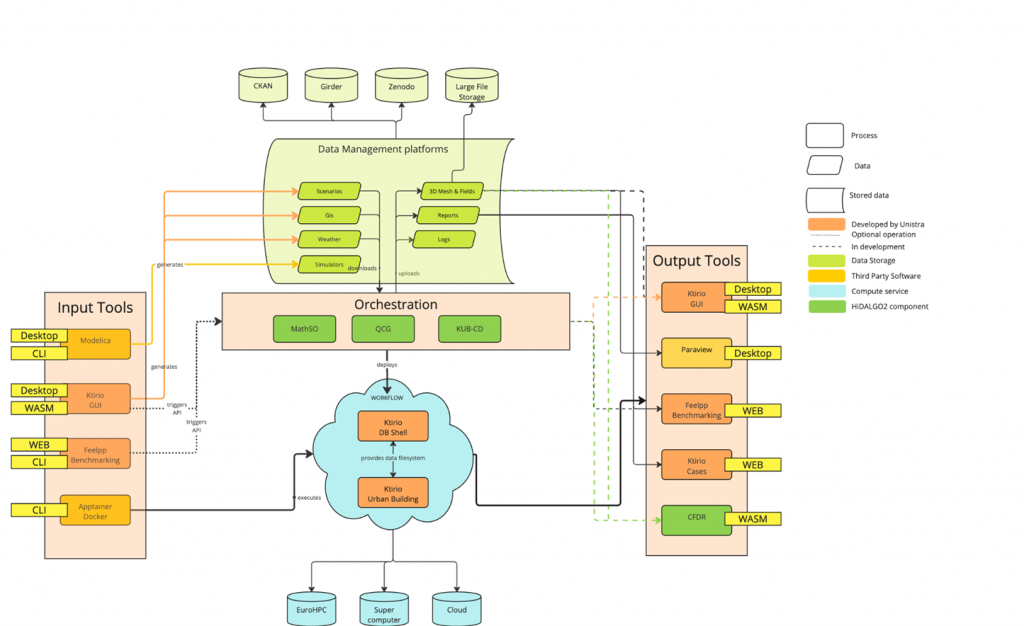
Ktirio Software Ecosystem
Ktirio Urban Building Software Workflow

The Ktirio Urban Building application, a pilot of the CoE HIDALGO2, is structured into a sophisticated software architecture leveraging multiple input and output tools, data management platforms, orchestration layers, and computational infrastructures.
In the following descriptions, software components are categorized using the following indicators:
Input Tools
In-House
- Modelica: A desktop application Dymola used via CLI to generate urban building models.
- Ktirio GUI (Desktop/WASM): Graphical interface for interactive modeling and data input generation.
- Feelpp Benchmarking (CLI,CI/CD,Web): CLI and automated CI/CD performance benchmarking and Web performance reporting based on Reframe-HPC.
- Apptainer & Docker (CLI,CI/CD): Containerization for consistent, reproducible software execution environments, generated and deployed via CLI or CI/CD.
Data Management Platforms
Data handling is facilitated through centralized repositories:
In-House
- Girder: Dataset management and metadata repository used via API and Web
CoE HIDALGO2 Partners
- CKAN: Dataset management and metadata repository used via API and Web
External
- Zenodo: Dataset management and metadata repository used via API and Web for long-term archiving and data sharing.
- Large filesystem storage on HPC systems: Used for handling significant volumes of data, including inputs and outputs of simulations.
The primary types of data managed include:
- Scenarios: Model simulations and setups.
- GIS Data: Geographic information systems data (building, vegetation, urban environment) utilized in modeling.
- Weather Data: Meteorological inputs for simulation accuracy.
- Simulator Outputs: Results generated by simulation processes, including 3D meshes, fields, detailed simulation reports, and logs.
Orchestration
Automated workflow management and computational orchestration leverage:
In-House
- Ktirio Urban Building CD / GitHub Actions – GitLab CI: Continuous deployment for automating workflows and resource management on cloud and HPC systems.
CoE HIDALGO2 Partners
- MathSO: Distributed computing resource management.
- QCG: Distributed computing resource management.
Computational Infrastructure
The software leverages various compute services and high-performance computing (HPC) resources:
In-House
- Ktirio DB Shell: Centralized database management tool to upload/download input/output resources on infrastructure
- Ktirio Urban Building: Application for energy modeling and simulation from building to city scale and beyond, running on:
- EuroHPC
- Supercomputers
- Cloud computing resources
Output Tools
For analysis and visualization of simulation outcomes, the following tools are used:
In-House
- Ktirio GUI: Interactive GUI in desktop and WebAssembly (WASM) for visualizing and managing results, enabling reloading and updating datasets
- Feelpp Benchmarking (Web): Web-based benchmarking analytics.
- Ktirio Cases (Web): Web-based application for managing and exploring statistically aggregated results.
CoE HIDALGO2 Partners
- CFDR (WASM): Computational Fluid Dynamics visualization and analysis through WebAssembly.
External
- ParaView (Desktop): Powerful scientific visualization software for large scale 3D visualisation.
“This software workflow supports the entire data lifecycle, from initial generation and model execution to final analysis and result sharing, ensuring robust management, performance evaluation, and knowledge dissemination for urban-building simulations.”
Ktirio Software Stack
The Ktirio Urban Building software leverages the capabilities of Feel++, an open-source software developed by Unistra and partners within the Feel++ Consortium, along with Modelica, to perform modeling and simulation of single buildings. Feel++ provides advanced numerical methods, particularly finite element analysis, enabling efficient simulation of complex physical processes such as heat transfer, airflow, and fluid dynamics. Through the Dymola environment, Modelica offers powerful tools for multi-domain system modeling, supporting detailed representations of building energy systems and their interactions within urban contexts. These frameworks form a robust and scalable platform for accurate urban building simulations and energy optimization.
Ktirio Software Stack
Part of the Ktirio Software Workflow and Stack is available either as source code or as Docker/Apptainer containers:
| Name of Software | URL | Availability | License |
|---|---|---|---|
| Feel++ | >github.com/feelpp/feelpp | Source, Binary | LGPL-3.0 WITH GPL-3.0 |
| Feelpp Benchmarking | >github.com/feelpp/benchmarking | Source | GPL-3.0 |
| Feel++ Docker and Apptainer Images | >github.com/feelpp/feelpp/pkgs/container/feelpp | Binary | LGPL-3.0 WITH GPL-3.0 |
| Ktirio Urban Building | >github.com/feelpp/ktirio-urban-building | No | Closed; Proprietary; |
| Ktirio Urban Building CD / Github Actions – Gitlab CI | >github.com/feelpp/feelpp-kub | Source | Currently closed; will be open-source using GPL-3.0 |
| Ktirio GUI | >github.com/feelpp/ktirio-gui | Binary | Closed; considering distribution via WebAssembly |
| Ktirio DB Shell | >github.com/feelpp/ktirio-urban-building | No | Closed; Proprietary; |
| Ktirio Geom | >github.com/feelpp/ktirio-geom | No | Closed; considering dual licensing |
| Ktirio Urban Building Docker and Apptainer Images | >github.com/feelpp/ktirio-urban-building/pkgs/container/ktirio-urban-building | Binary | Proprietary; Evaluation-only; |
- LGPL-3.0: Lesser General Public License v3.0 – Permissive open-source license allowing reuse with conditions. [>details]
- GPL-3.0: General Public License version 3, requiring derivative works to also be open-sourced under the same license. [>details]
- Closed; Proprietary: Software with restricted access and rights; no distribution or modification without explicit permission.
- Closed; considering distribution via WebAssembly: Currently closed-source; future plans for controlled distribution through WebAssembly.
- Proprietary; Evaluation-only: Restricted usage license for testing and evaluation purposes only; distribution and production use prohibited.
